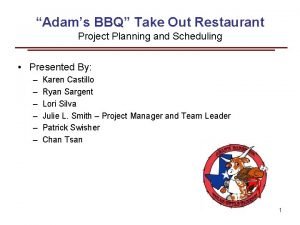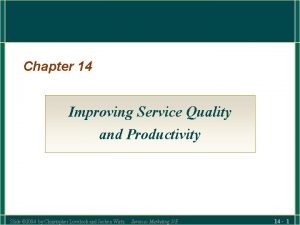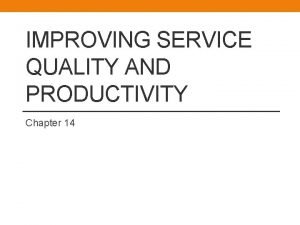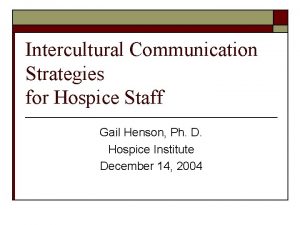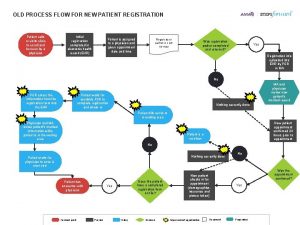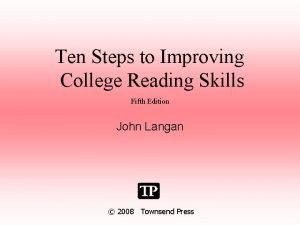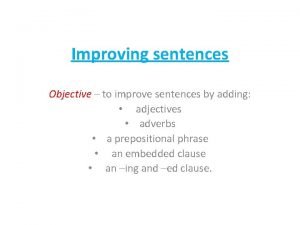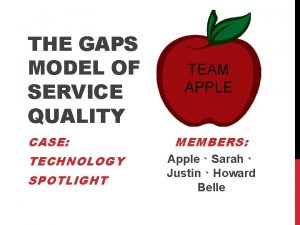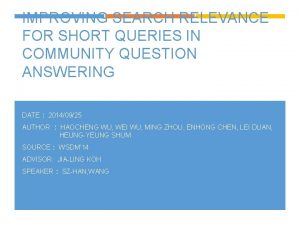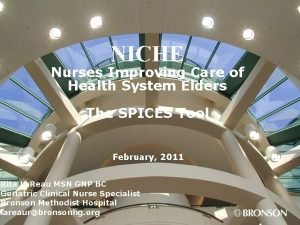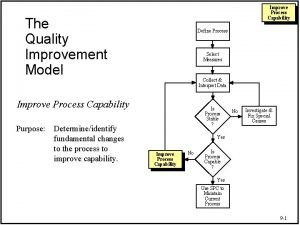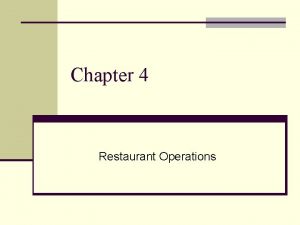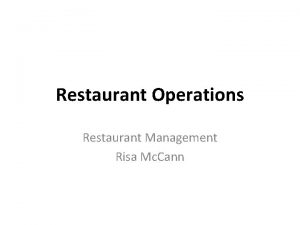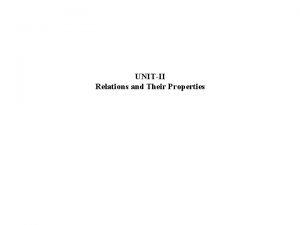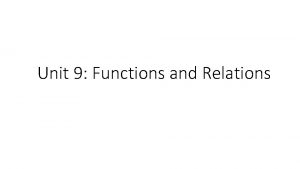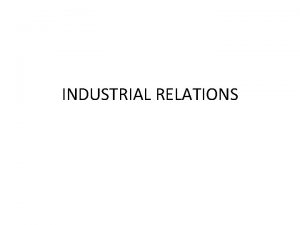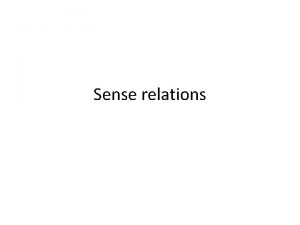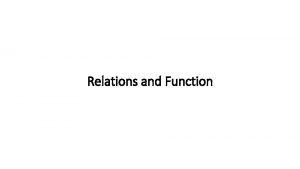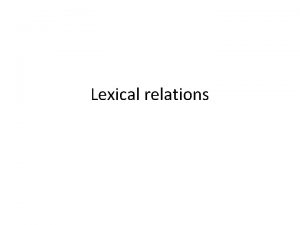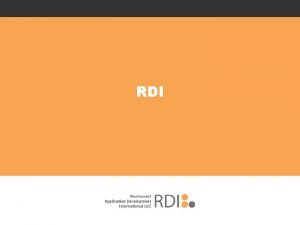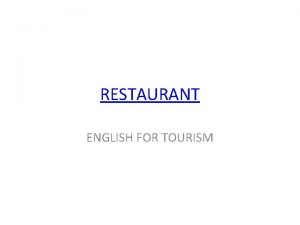Restaurant Operations at Samouels Restaurant Improving Relations with


























- Slides: 26

Restaurant Operations at Samouel’s Restaurant: Improving Relations with Employees and Customers Research conducted for: Phil Samouel, Samouel’s Greek Cuisine Research conducted by: Ad. Mark International Business Research Group

Initial Symptoms: o o Inadequate Revenue. Inadequate Profit. 100% Annual Employee Turnover. Need to Attract New Customers.

Two Studies in One o Employee Survey: n Focus on attracting and keeping customers. o Customer Survey: n Focus on increasing employee commitment and maximizing productivity.

Overall Research Questions o Employee Study: n RQ 1: Are employees being managed to maximize their productivity as well as commitment to the success of the restaurant? o Customer Study: n RQ 2: What are the ways to keep and grow the existing customer base and to attract new customers?

Employee Survey Hypotheses: EH 1 o EH 1: Employee work status, age and gender are related to intentions to job search. Should consider the search intentions of: § § § part-time workers younger employees men

Employee Research Hypotheses o EH 2: Employee perceptions of supervisory style are positively related to organizational commitment. o EH 3: Employee perceptions of work group functioning are positively related to organizational commitment.

Customer Hypotheses: o CH 1: Samouel’s customers report higher satisfaction than do Gino’s customers. o CH 2: Customer perceptions of restaurant employees are related positively to customer satisfaction. VS.

Customer Hypotheses: o CH 3: Customer perceptions of restaurant atmosphere are related positively to customer satisfaction. o CH 4: Customer perceptions of food quality are related positively to customer satisfaction.

Research Methods: Employee Study o 63 Samouel’s Employees Sampled. n off premises. n employees Not “Identified”. o General Social-Psychological Measures Used for: n work environment variables. o such as organizational commitment. n work outcome characteristics. o such as quitting intention.

Research Methods: Customer Study o Two Samples: n Samouel’s Customers. n Gino’s Customers. o 200 usable responses obtained from 230 total / 100 for each. o Measures: n 7 -Point Likert scales assess: o Ratings of evaluative criteria; n Outcomes: Satisfaction and intention to return.

Results: Employee Study o EH 1: Intention to Search Results. n Full versus part-time. Part-time workers are more likely to search.

EH 1: Age and Search Intentions Search intentions become lower with age!

EH 1: Gender and Search Intentions Men are more likely to search for another job!

EH 1: Search Intentions by Years of Employment Newer employees are more likely to search for another job!

EH 2: Supervisory Style and Organizational Commitment: Regression Results o Model Explains Loyalty (X 13) n R 2 =. 41, F = 13. 4, p <. 001 o Work Group Cooperation and Training affect Loyalty positively. o Team Functioning negatively? t Sig. Mean 3. 40 . 001 3. 89 X 8 – Team -. 355 -2. 01. 049 3. 41 X 11 – Training 3. 96 3. 57 Work Group Variable: β X 14 Cooperation . 579 2. 69 . 009

Caution: o Negative team functioning – loyalty relationship based on regression coefficient may be misleading. n All correlations are positive. n Further examination required.

Results: Customer Study Hypothesis Summary 1. 2. 3. 4. VS. Relative Satisfaction. Determinants of Customer Satisfaction. Effect of Atmosphere on Satisfaction. Effect of Food Quality on Satisfaction.

Comparative Performance 1. All differences but variety are significant. 2. Notice Samouel’s is cleaner, has a nicer interior, and is more fun to go to.

CH 1: Customer Satisfaction is higher at Samouel’s? Who is happiest? Gino! • Customers more satisfied with Samouel’s = no support! • 5. 96 compared to 4. 76. ü t = -7. 79 (p<. 001)

Customer Satisfaction at Gino’s: Regression Results ü Variables together Variable: β t p . 512 4. 86 . 001 ü Variables X 1 – Food Quality (CH 4) X 2 - Interior Attractive (CH 3) . 034 0. 37 . 368 X 10 -Comp. Employees (CH 2) . 373 3. 54 . 001 R 2 . 261 F= 11. 3 . 001 “explain” satisfaction. “explanatory” power: ØX 1 – 1 st ØX 10 – 2 nd ü X 2 is not significant.

Customer Satisfaction at Samouel’s: Regression Results Variable: β t p X 1 – Food Quality (CH 4) . 301 3. 50 . 001 X 2 - Interior Attractive (CH 3) . 158 1. 88 . 063 X 10 -Comp. Employees (CH 2) . 395 4. 72 . 001 R 2 . 440 F= 25. 2 . 001 ü ü Variables together “explain” satisfaction. Variables’ “Explanatory” Power: Ø X 10 – 1 st Ø X 1 – 2 nd Ø X 2 – 3 rd

Conclusions: Employees o Employees with higher turnover likelihood: n Younger n Part-time n Male o Supervisory approach is good. o Work group functioning is not good.

Conclusions: Customers o Gino’s customers are more satisfied. n Gino’s food is higher quality. n Gino’s employees are rated better. o Samouel’s customers’ satisfaction affected by: n Food quality, attractiveness of interior, and friendly employees. o Gino’s customers’ satisfaction affected by: n food quality and employee friendliness.

Recommendations: 1. Provide Additional Training Opportunities for Employees. 2. Hire Employees 25 and Over. 3. Hire an “Executive Chef” – improve the food quality. 4. Promote the importance of a clean, attractive and fun atmosphere.

Limitations o Samples are limited. n many more restaurant competitors – each with potentially unique customers and employees. o Questionnaires do not cover all important topics. n many more issues to be studied, such as compensation systems, full versus part-time, price sensitivities…

Finally. . . o Thanks for the opportunity to help Samouel’s. o Please ask any questions!
 Work breakdown structure for restaurant
Work breakdown structure for restaurant Employee relations in public relations
Employee relations in public relations Improving decision making and managing knowledge
Improving decision making and managing knowledge Improving security performance
Improving security performance Service quality and productivity
Service quality and productivity Gaps model for improving service quality
Gaps model for improving service quality Strategies for improving intercultural communication
Strategies for improving intercultural communication Patient registration process flowchart
Patient registration process flowchart What is hill's prescription for improving one's vocabulary
What is hill's prescription for improving one's vocabulary 10 steps to improving college reading skills
10 steps to improving college reading skills Improving critical infrastructure cybersecurity
Improving critical infrastructure cybersecurity Boring sentences to improve
Boring sentences to improve Listening gap communication
Listening gap communication Ahrq safety program for improving antibiotic use
Ahrq safety program for improving antibiotic use Improving student learning one teacher at a time
Improving student learning one teacher at a time Improvement of software economics
Improvement of software economics Using assessment data for improving teaching practice
Using assessment data for improving teaching practice Nist framework for improving critical infrastructure
Nist framework for improving critical infrastructure A linear-time heuristic for improving network partitions
A linear-time heuristic for improving network partitions Improving search relevance
Improving search relevance Nurses improving care for healthsystem elders
Nurses improving care for healthsystem elders Improving vocabulary skills chapter 9
Improving vocabulary skills chapter 9 Improving productivity at starbucks
Improving productivity at starbucks Thinking synoynm
Thinking synoynm Improving operational performance
Improving operational performance Aliens meaning
Aliens meaning Improving process capability means;
Improving process capability means;
